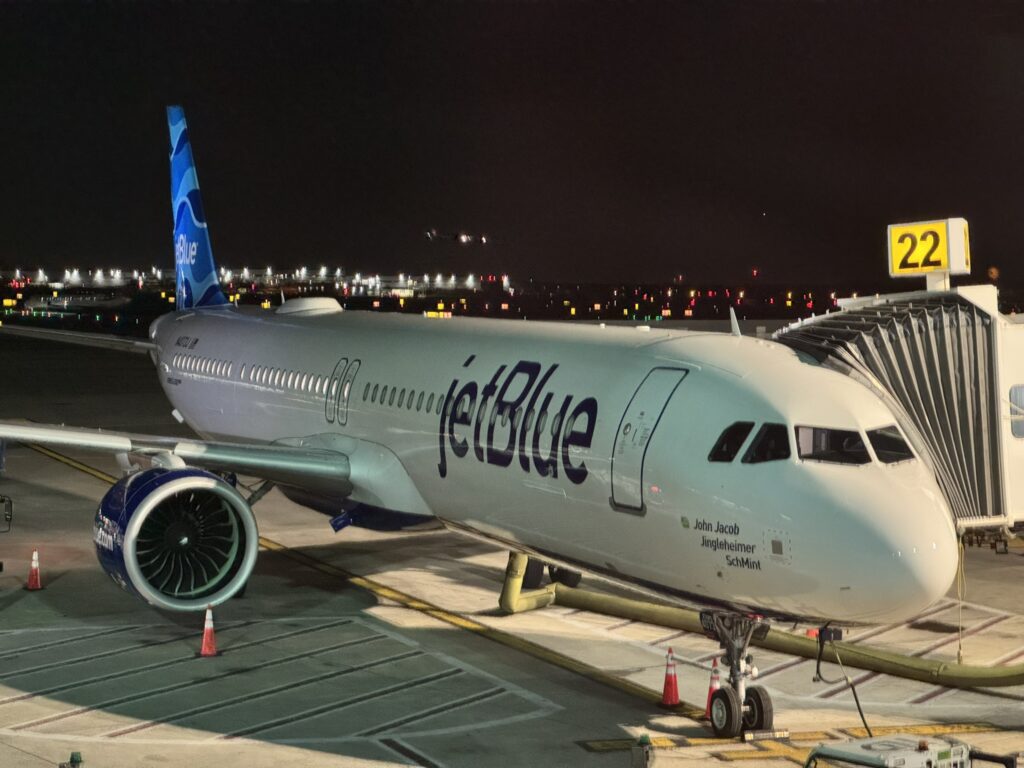Today’s airline passengers have different needs and expectations than the passengers of yesteryear, including when it comes to inflight connectivity. To wit, when JetBlue Airways and its partner Viasat pioneered the launch of full, fast, free inflight connectivity in 2013, customers utilized download capabilities far more than upload.
Back then, the ratio between download and upload was about ten to one. “Ten things were downloaded for every one thing uploaded,” JetBlue manager IFE&C Ken McQuillan said at the APEX TECH conference in Los Angeles. And for over a decade, that paradigm remained relatively static. However, the past two years have ushered in massive change.
Now the download/upload ratio is “like three to one, and it’s probably going to be two to one, and one to one over the next probably two years,” McQuillan said, highlighting a fundamental change in passenger behavior. “That’s huge, right? Our systems aren’t really capable of sustaining that.”
JetBlue’s fleet is fitted with Viasat’s high-capacity Ka-band geostationary (GEO) satellite-based IFC system. The presently standalone GEO system, said McQuillan, has served JetBlue well and Viasat is an “excellent” partner. Even so, whilst streaming OTT is actually easy for JetBlue and its aero ISP, “It’s other things that are required, both the down- and upload that are really constraining the network.”
With TikTok, Instagram, YouTube and Facebook boasting billions of users, it won’t surprise you, dear reader, to learn that JetBlue’s customers are using a lot more heavily video-centric and auto-playing apps on board than in 2013.
“They’re using things that really require a lot of resources, much more than what they’ve required in the past,” noted McQuillan. “People are expecting to be able to do things on the plane that they do in their office or do at their house, and that has really kind of put a strain on everything because there’s a lot of demand right now, and it’s just really showing that we have to think well ahead of what’s the next thing going to be, what our customers would expect.”
And therein lies the challenge facing not only JetBlue but virtually every airline that cares deeply about the passenger experience and meeting the connectivity needs of the modern traveler both today and in the future. Technology is changing at breakneck speeds. But as a wealth of new IFC options come to market, how can airlines avoid buyer’s remorse and fear of missing out?
McQuillan said he is not surprised that industry is gravitating towards multi-orbit and even more agnostic IFC solutions to take advantage of emerging technology.
After all, there are redundancy and resiliency arguments to be made for not being locked into a single orbit or indeed a single network. And in time, there might even be an argument to be made for having more than one service provider on board an aircraft.
For its part, JetBlue’s partner Viasat is not sitting on its hands. It has announced an Amara-branded nextgen IFC roadmap for airlines that will enable it to support multi-orbit IFC over its current GM-40 gimbaled antenna, using both its own Ka-band GEO satellite assets and Telesat’s forthcoming Ka-band Low Earth Orbit (LEO) service, when the latter is available in roughly the 2027 timeframe.
Ultimately, Viasat expects to bring a dual-beam electronically steerable antenna to market that will be able to simultaneously talk to LEO and GEO, with the intent of running latency-sensitive applications over LEO and high-density tasks, like streaming video, over GEO (but it might also simply pair a LEO-only antenna with its existing GM-40 hardware.)
Understandably, given the hotly competitive nature of the airline market right now, McQuillan would not be drawn on the specifics of JetBlue’s own nextgen IFC strategy but speaking broadly he admitted that Amara is “absolutely” the sort of roadmap that JetBlue wants to see.
“[V]iasat going towards a multi-orbit solution is great for the industry, right? Viasat carries a lot of weight with their name in their product. And so them embracing multi-orbit is very important for the airline industry because they have a lot of customers, and those customers are going to be looking for something beyond just a single GEO solution on their aircraft.
And also, there might be a solution… maybe just a single antenna that does everything, right, that’s a great solution. There’s also other options of dual antennas, so there’s definitely a lot of positivity out there, especially when Viasat are willing to look at this new technology and say, ‘hey, maybe we’re not gonna keep all our eggs in that one GEO basket.’
And it’s very important for us as an airline because we look at that and say, ‘okay, when we’re lining up for the future, we need to look at not only what’s available today, but what could be available down the road. What we sign up with today, by the time we implement something, technology on our aircraft, we’re looking at maybe 18 months, two years, everything can be changed again, right?
Having a parter that’s open to change and forward-looking is vital to JetBlue.
“And I think, as an airline, you really need that. You need someone to provide you with solutions that are for longer than just today,” McQuillan confided as a panelist on the IFC Revolution session moderated by your author at APEX TECH.
Related Articles:
- Viasat details Amara nextgen inflight connectivity strategy
- Blazing fast Internet on an RJ? Air Canada stuns in free Wi-Fi rollout
- American Airlines trials free inflight Wi-Fi before 2026 launch
- VIDEO: Delta innovates with Hughes partnership, IFEC integration
- JetBlue’s Anna Sieber helms Seamless Air Alliance Airline Forum
- JetBlue designs Blueprint for sensibly personal IFE experience
- Viasat reveals details about cross-roaming play, Telesat prep
All images of JetBlue aircraft credited to Jason Rabinowitz












